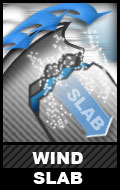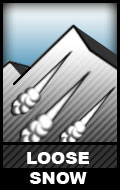Midweek Avalanche Update
This is a regional backcountry avalanche forecast for the Western Chugach Mountains of Chugach State Park. It is provided pro bono by a local avalanche professional, is based on limited field data for a large area, and is meant to be used only as a general baseline for recreationists’ personal and specific assessment in the field. The Anchorage Avalanche Center and associates assume no responsibility or liability for the use of this information. Anyone using this information needs to be formally educated in regard to avalanches and backcountry travel. Please encourage statewide investment in high quality outdoor and environmental education via K-12 public schools, as this is the best way to ensure all Alaskans are “avy savvy.”
Click the hyperlinks and icons for further learning.
Get outside and enjoy The Greatland! This is a midweek avalanche update for March 4-6, 2020.
The avalanche danger Wednesday-Friday this week is expected to be moderate. Heightened avalanche conditions exist in some areas and on certain terrain features. While natural avalanches are unlikely, human triggered avalanches are possible. Be sure to evaluate the snow carefully, and practice effective terrain management to minimize exposure to potentially dangerous avalanche terrain and reduce the consequences if an avalanche is triggered.
Generally, the persistent slab danger is expected to be higher in northern areas of the park (i.e. Eagle River to Knik). Wind slab danger is expected to be higher at the uppermost elevations, and in the Front Range (Ship Creek to Indian Creek).
Saturday night through Monday morning delivered a copious amount of dry, low-density powder to the Western Chugach Mountains of Chugach State Park. As of Tuesday, this very high-quality snow was only slightly wind-affected and provided EXCELLENT riding conditions. The recent snow is expected to become more wind-affected through the week, but riding quality is expected to remain decent in sheltered areas. Expect more wind-affected snow in the uppermost elevations, and in the southern areas of the park (i.e. Front Range).
Problem 1 – Wind Slab
Human triggered wind slabs up to D2 (large enough to bury, injure, or kill a person) in size are possible on leeward terrain (especially southerly aspects) steeper than 35º above 2500′.
Moderate northerly winds forecast this week will build fresh wind slabs in the upper elevations, primarily along ridges and near peaks.
There is a lot of very low density (“blower”) powder available for transport. It won’t take much wind to wind-load leeward, upper elevation terrain.
Wind slabs are most likely on convex and/or unsupported terrain features.
Be on the lookout for red flags of wind slab danger (recent avalanches, shooting cracks, active wind loading). Pay close attention to the appearance and texture of surface snow: this is a way to identify potentially dangerous, wind-loaded terrain. Wind-loaded snow may look pillowy, bulbous, relatively deep (“fat”), and have a buffed or etched texture. Dangerously wind-loaded snow may feel hollow and punchy, indicating a denser slab overlying looser and weaker snow.
Pole probing and quick hand pits are a great way to assess wind slab danger near the surface. Expert skiers and backcountry travelers may be able to use prudent ski cuts to assess and manage the wind slab problem. However, wind slabs have the potential to “step-down” and trigger larger and more dangerous persistent slabs.
Remember that terrain traps can make even a small avalanche deadly. Be mindful of the consequences if you were to fall or lose control due to triggering just a small slab. Beware of exposure where a fall or slip could cause trauma, as well as channeled terrain features that might cause even a small amount of debris to pile up deeply.
Problem 2 – Persistent Slab
Human triggered persistent slab avalanches up to D3 (large, deadly, and destructive) in size are possible above 2500′ on all aspects.
While persistent slab danger is generally on the decline, it remains a lower probability but potentially very high consequence problem. A human triggered persistent slab may be very difficult to escape, as a person may be able to get into the middle of the slab before it releases from above with hard slab characteristics. The hard slab nature of the debris also makes trauma more likely.
Persistent slabs are expected to only release from terrain steeper than 35º and generally be stubborn for a human to trigger, but in some areas of the park (i.e. northern areas that have a typically thinner and trickier snowpack: Eagle River to Knik) it may still be possible to remotely trigger a persistent slab. Be mindful of lower angle terrain where a hard slab may be connected to a steeper slope capable of producing a dangerous persistent slab.
Multiple persistent weak layers exist in the Chugach State Park snowpack. In general; basal facets and depth hoar exist near the ground, a significant layer of extensively faceted snow that developed December-January is buried mid snowpack, and thinner layers of less extensively faceted February snow are buried closer to the surface. These weak layers are sandwiched between wind-packed hard slabs of varying thickness.
Snowpits and stability tests continue to evidence propagation propensity. The relatively hard wind-packed layers may be able to bridge the weight of a human trigger, but if a weak spot is found (likely where the wind-packed, hard slab layer is thinner and/or less supportable) a dangerous avalanche could result.
There is no effective way to manage this perplexing avalanche problem other than simply avoiding terrain capable of producing a dangerous persistent slab avalanche, especially steep and open slopes that are convex or unsupported. Assessment of this problem in the specific area in which you’re traveling will require thorough snowpack investigation: digging a snowpit, analyzing the stratigraphy, and conducting stability tests like the ECT. As always, be mindful of red flags (especially recent avalanches, collapsing or “whumphing,” shooting cracks, active loading, etc.) and be very diligent about safe travel protocols.
Problem 3 – Loose Snow
D1 human triggered loose snow avalanches (aka “sluffs“) are possible on wind-sheltered terrain steeper than 40º.
Again, be mindful that terrain traps can make even a small avalanche dangerous. Consider the consequences if you were to fall or lose control due to being hit by your sluff.
Problem 4 – Cornice Fall
Longstanding cornices over typically leeward slopes (primarily west clockwise through north aspects above 2500′) are large in many areas of Chugach State Park. Fresh cornices over less typically leeward northerly aspects are expected to develop this week from forecast north winds. Give corniced ridges a wide berth; cornices may break off further back than expected. Do not approach the edge of a snow-covered ridge, unless you’re sure it’s not corniced. A cornice fall itself is dangerous, especially if the human trigger falls onto exposed terrain. Cornice falls may also trigger slab avalanches as they “bomb” the slope they fall onto.
Danger Trend
Steady.
Mountain Weather
Expect generally sunny skies with light to moderate northerly winds and COLD temps (wind chill values could be potentially dangerous – make sure you’re prepared to adequately protect all exposed skin).
Best wishes for your work week!
Please let us know what you’re seeing by tagging us on Instagram @anchorage_avalanche_center, submitting an observation, sending an email to info@anchorageavalanchecenter.org, or via FaceBook message. All observations help us provide the public with a better forecast product – no matter how basic. We are more than willing to keep observations confidential, and only use the information to inform forecast products.
Funding and resources for this forecast generously provided by the Post-Capitalists and Libertarian Socialists of Alaska who encourage you to #FeelTheBern, #DumpTrump, #RecallDunleavy, and tell Murkowski, Young, and Sullivan that this is their last term! Our democracy and planet are at stake, stand up and fight the power!




